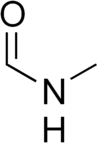N-Methylformamide
N-Methylformamide (NMF) is a colorless, nearly odorless, organic compound with molecular formula CH3NHCHO, which is a liquid at room temperature. NMF is mainly used as a reagent in various organic syntheses with limited applications as a highly polar solvent.[1]
 | |
 | |
| Names | |
|---|---|
| Preferred IUPAC name
N-Methylformamide | |
| Other names
Methylformide NMF N-methylmethanamide | |
| Identifiers | |
3D model (JSmol) |
|
| 1098352 | |
| ChEBI | |
| ChEMBL | |
| ChemSpider | |
| ECHA InfoCard | 100.004.205 |
| EC Number |
|
| KEGG | |
| MeSH | methylformamide |
PubChem CID |
|
| RTECS number |
|
| UNII | |
CompTox Dashboard (EPA) |
|
| |
| |
| Properties | |
| C2H5NO | |
| Molar mass | 59.068 g·mol−1 |
| Appearance | Colourless liquid |
| Odor | fishy, ammoniacal |
| Density | 1.011 g mL−1 |
| Melting point | −4 °C (25 °F; 269 K) |
| Boiling point | 182.6 °C; 360.6 °F; 455.7 K |
| Miscible | |
Refractive index (nD) |
1.432 |
| Thermochemistry | |
Heat capacity (C) |
125.2 J K−1 mol−1 |
| Hazards | |
| GHS pictograms |   |
| GHS Signal word | Danger |
GHS hazard statements |
H312, H360 |
| P280, P308+313 | |
| Flash point | 111 °C (232 °F; 384 K) |
| Lethal dose or concentration (LD, LC): | |
LD50 (median dose) |
4 g kg−1 (oral, rat) |
| Related compounds | |
Related alkanamides |
|
Except where otherwise noted, data are given for materials in their standard state (at 25 °C [77 °F], 100 kPa). | |
| Infobox references | |
NMF is closely related to other formamides, notably formamide and dimethylformamide (DMF). However, industrial use and production of NMF are far less than for either of these other formamides. DMF is favored over NMF as a solvent due to its greater stability.[1] Annual production of NMF can be assumed to be significantly less than the production of either formamide (100,000 tons) or DMF (500,000 tons).[1]
Structure and properties
Like DMF and formamide, each of the two rotamers of NMF are described by two principal resonance structures:
This description highlights the partial double bond that exists between the carbonyl carbon and nitrogen, which gives rise to a high rotational barrier. Thus, the molecule is not able to freely rotate around its main axis and the (E)-configuration is preferred due to steric repulsion of the larger substituents.
Preparation
NMF is typically prepared by allowing methylamine to react with methyl formate:[1]
- CH3NH2 + HCOOCH3 → CH3NHCHO + CH3OH
A less common alternative to this process is transamidation involving formamide:[1]
- HCONH2 + CH3NH2 → CH3NHCHO + NH3
Uses
NMF is a specialized solvent in oil refineries. It is a precursor in specialized amidation reactions where formamide would not be suitable. These reactions can generally be categorized by the following equation:
- R-Lg + CH3NHCHO → R-NCH3CHO + H-Lg (where Lg is a leaving group).[1]

Laboratory uses
NMF is the precursor to methyl isocyanide, a ligand in coordination chemistry.[2] NMF is used as a solvent in Aluminum Electrolytic Capacitors.
References
- Bipp, H.; Kieczka, H. "Formamides". Ullmann's Encyclopedia of Industrial Chemistry. Weinheim: Wiley-VCH. doi:10.1002/14356007.a12_001.CS1 maint: multiple names: authors list (link)
- Schuster, R. E.; Scott, J. E.; Casanova, J. Jr. (1966). "Methyl Isocyanide". Organic Syntheses. 46: 75.CS1 maint: multiple names: authors list (link); Collective Volume, 5, p. 772
